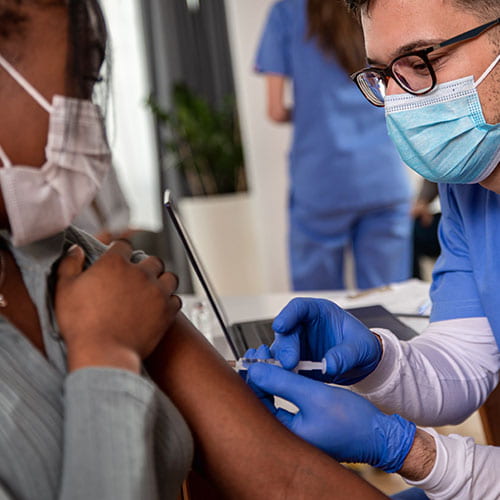By Stanley Tsou
Intern, Science and Technology Policy Program
Rekha Lakshmanan
Contributing Expert, Science and Technology Policy Program
Even as COVID-19 vaccines have become widely available in the state of Texas and across the nation, inequities in immunization rates persist among minority populations and residents in rural counties. According to recent data from the Kaiser Family Foundation, only 33% of the total Black population and 40% of the total Hispanic population in Texas have received at least one dose of the COVID-19 vaccine, compared to the statewide average of 51%. Vaccination coverage also varies widely between rural and urban counties, and residents of rural counties often travel farther to receive the vaccine compared to residents in urban areas. In addressing the various barriers that could contribute to the disparate rates of immunization and vaccination coverage, collecting immunization data and disseminating accurate immunization information play a critical role in developing programs to target those most at risk or in need. The recent passage of Senate Bills (SB) 1353 and 239 at the 87th Legislative Session marks an important step toward ensuring equitable distribution of vaccines across the state of Texas and addressing inequities in future public health emergencies.
Signed by Gov. Greg Abbott on June 14, 2021, both bills address the importance of disseminating immunization information during states of emergency. SB 1353, authored by Sen. Borris Miles (D), co-authored by Sens. Eddie Lucio Jr. (D) and Kel Seliger (R), and sponsored by Representative Bobby Guerra (D), augments immunization reporting by requiring the Department of State Health Services (DSHS) to include information in its biennial immunization report on immunization accessibility by age, race and geographic location, as well as recommending legislative actions to increase immunization rates, particularly among communities of color and residents of rural areas. In times of a public health crisis such as the COVID-19 pandemic, more data helps health officials ensure equitable distribution of vaccines and is integral for assessing the epidemiological situation. The provisions set out in SB 1353 can help policymakers review and update local public health guidelines in accordance with current vaccine availability.
Similarly, SB 239, authored by Sen. Beverly Powell (D) and sponsored by Rep. Nicole Collier (D), stipulates that the DSHS develop and implement a disease prevention information system for disseminating immunization information during a declared or local state of disaster. In particular, DSHS should ensure that educational materials regarding immunization schedules and locations of local health care providers are available for distribution to agencies such as schools, child care facilities and veterans’ homes. By partnering local health authorities with community organizations, the bill facilitates the dissemination of accurate information via trusted channels. With many disparate communities, especially within urban centers, and rural residents having limited access to health care facilities, effective communication efforts on the availability of vaccines are critical for mitigating public health crises. As the bill becomes effective on Sept. 1, 2021, SB 239 will help leverage existing infrastructures and support local health authorities to provide accurate and timely immunization information when a disaster occurs.
In a time when COVID-19 misinformation has spread rampantly across social media platforms and online forums, ensuring transparent and equitable access to immunization information is essential for fostering public trust in government-organized vaccination campaigns. These two bills, SB 1353 and SB 239, will help increase access to immunization information during times of emergency and disaster. Should future emergencies or disasters strike, knowing the current immunization rates and vaccine availability can help identify priorities for disaster response and determine the need for additional resources. Moreover, it can support vulnerable populations in making well-informed decisions and taking appropriate actions to protect their own health and safety and that of others.
